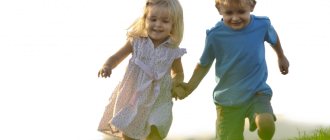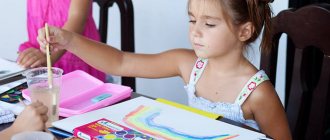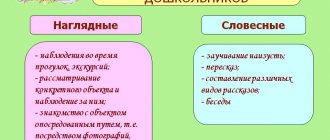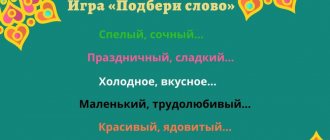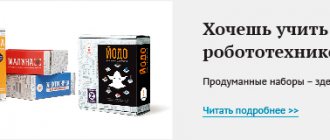The formation and active development of the level of coherent speech for preschoolers requires not only the increased attention of both parents, but also specialized classes that can be conducted in a playful or theatrical form, which is especially attractive to children. In the process of working with children, speech therapists and teachers use many modern techniques, among which mnemonics stands out, aimed at actively developing the level of coherent speech and memory in preschool children.
What is mnemonics
Mnemonics for increasing the level of speech development is a set of techniques aimed at improving perception with memorization of various information using sound samples and visual illustrations.
Provided that classes are carried out systematically, mnemonics for speech development allow you to:
- improve the memorization of heard texts in the form of stories, fairy tales, etc.;
- transform visually acquired data into abstract (and vice versa);
- create logical chains of events;
- Expand words knowledge;
- stimulate the development of imagination and thinking;
- develop children’s ability to compose complex sentences of a descriptive type, which include many words.
Mnemonics, as one of the most effective methods of memorization, is actively used not only by speech therapists, but also by teachers in kindergartens and other preschool institutions.
There are no age restrictions for classes, but many specialized experts recognize the age of 4-5 years as the most optimal, when children already have a fairly rich and varied stock of words and phrases that they can actively use.
The main tool that is used in mnemonics for developing the level of coherent speech in preschool children are mnemonic tables - specific diagrams in which certain information data is embedded.
Mnemonic diagrams for the little ones should be painted in bright shades so that the image that a frog is green, a chicken is yellow, etc. is imprinted in their minds.
For older children, it is preferable to use single-color schemes that do not distract attention, distracting them with additional, and often unnecessary, details.
Benefits of classes
As the baby grows up, he should gradually be involved in the reading process. To do this, you can use aids such as fairy tales and stories with pictures instead of individual words. Such exercises will bring a lot of benefits to a child who does not yet know how to read:
- perception - the child learns to recognize what is shown in the picture;
- attention - concentrate on the subject and name it in time;
- speech - looking at the image, the baby can independently tell the story;
- memory - retelling a story from memory.
By the way, a similar technique is used by psychologists in kindergartens to test children’s knowledge and speech development.
Fairy tales with pictures instead of some words are also useful for children who are already learning to read. For example, if the baby already knows the letters, but it’s hard for him to combine them into words, then the picture will help him get a little distracted. As a result, he will not perceive reading as something tedious, and therefore will remain interested in learning. A similar effect will also help parents of those children who immediately dislike reading.
In addition, stories with pictures instead of individual words perfectly develop imagination and promote speech development. And this, in fact, is the main reason why children really need to read.
Books in which some words are replaced with drawings are also actively used in their practice by speech therapists. As a rule, the child does not try to pronounce words with sounds that are difficult for him to pronounce. But in the process of reading a funny fairy tale together, the baby becomes liberated, which greatly facilitates the specialist’s work in terms of producing a particular sound. A speech therapist hears how a child pronounces words with sounds that are difficult to pronounce in a normal, relaxed environment and makes a conclusion about whether there is an improvement after classes or not.
Areas of use of mnemonic tables
Mnemonic tables for the formation and development of coherent speech (developmental and educational) are images of textual information that is previously divided into groups of words in sequential order. There is one illustration for each group of words. Thanks to such a schematic sketch of information, the baby easily perceives it, remembering everything without much effort.
Using mnemonic tables for speech development, the following is carried out:
- Memorizing fairy tales or rhymes. Young children take part with great interest in educational games based on fairy tales they know. At home, you can invite your child to tell a story to his favorite toy, using a series of pictures. You can also draw a mnemonic table together, depicting the heroes of events with your own invented symbols, for example, a triangle is a person, a wavy line is a cloud in the sky. Thus, not only the formation of coherent speech occurs, but also the active development of imagination and fantasy with the manifestation of the hidden creative abilities of children.
- Learning general rules, such as how to brush your teeth correctly. The diagrams depict the sequence of all manipulations that are easily perceived and remembered.
- Compiling stories describing objects, events, pets, etc. Focusing on pictures that answer basic questions: who is it, what color is it, what sounds does it make, what does it like to eat, etc., children can create a consistent description.
- Working on a retelling. After reading the text, the most difficult words are highlighted, the meaning of which must be explained to the child. After the explanations, a conversation should be held on the entire content of the text with a demonstration of drawings from the mnemonic table. A joint retelling using pictures will allow the child to quickly remember information and tell the story he heard himself.
- Solving riddles. With the help of mnemonic tables, children learn to identify an exact object, focusing on its characteristics. At the first stage, it is necessary to explain to the child everything that is depicted in each picture, and only after that offer to independently guess the encrypted object.
Speech therapy classes on the development of coherent speech using a variety of mnemonic diagrams involve memorizing and deciphering the plot illustrations given in the table. The type and thematic content of mnemonic tables can be different; execution can be printed (Doman cards) or made by hand. Cards for speech development in the first lessons should be small with light storylines; it is recommended to place 3-4 of them in one row, in this position they are easier to perceive.
How to read stories with pictures correctly
An adult and a child take part in the reading. The adult reads the lettered part of the story and pauses when an image appears in the text. The child names what he sees in the picture.
Having reached the end of the text, the adult asks the question: “What was the story about?”, “What were the names of ... (the characters).” Answering these questions, the little person does a lot of brain work. He uses his memory to try to remember the text. Carefulness and logic, looking at the pictures, recreates the order of actions in the story. In the future, this knowledge will be consolidated in the subconscious, and it will be easier for the child to write summaries at school. He will learn to isolate certain points and, based on them, reproduce the entire text in memory.
Texts with pictures instead of some words are different:
- black and white;
- colorful;
- with stickers.
Their use largely depends on the age and level of development of the baby. For example, to make the baby more interesting, you can offer him to color black and white pictures. This will allow the little man to better remember the fairy tale and then tell it in his own words.
By the way, you should not use such manuals in electronic form. Young children get tired quickly when working with static pictures on a computer monitor or tablet screen. This means that such exercises will be ineffective.
So, if it is not possible to purchase fairy tales and stories with pictures instead of certain words, then it is better to download and print them. During the lessons, these leaves can be collected into a book, and then together with the child, make a cover for which he will come up with and draw some kind of picture.
How to create mnemonic tables
Drawing up mnemonic tables involves performing the following manipulations:
- breaking the text into parts (focusing on the most important points);
- dividing a sheet of paper into squares (the number of squares depends on the highlighted parts of the story);
- depiction of each moment in the picture (both nouns and adjectives can be described);
- words that are difficult to sketch (verbs or questions) can be depicted as a “?” (the child must comment on them).
To facilitate the perception of fairy tales or riddles by young children, the works are broken down into individual situations, which are subsequently transferred to pictures for children.
Pictures for speech development
Picture 1 This is Tanya and Vanya. They are brother and sister. One day Tanya and Vanya woke up and looked out the window. Oh, what beauty! Someone drew patterns on the glass. And outside the window... a white fur coat covered the whole world. What is this? That's right, there is snow on the branches. So, she came... (Talk to the child about the snow, frosty patterns on the glass, about bullfinches, about rowan trees, about trees that have shed their leaves.)
Picture 2
Tanya and Vanya love to play outside in winter. Do you love? Hurry up to the street! Tanya and Vanya are great, they dress themselves. Vanya put on overalls, but what is Tanya wearing? (Fur coat.) Do you like Tanya’s hat? Who has a better hat, Tanya or Vanya? What kind of hat do you have? What do you wear when you go out? (Talk with your child about winter clothes, their types, colors, etc.)
Picture 3
Who is this rushing on a sled down a snowy hill? (Tanya.) Do you think Tanya likes sledding? Where is Vanya? See how well he skis. I just lost my sticks somewhere. But look how he waves his hands! A real skier! What do you like to do more: skiing or sledding? (Talk to your child about the boy on the snow scooter, about your downhill ride, etc.)
Picture 4 Oh, there's so much snow outside! What big snowflakes are flying! Here is Vanya. He rolls a big ball. What did Tanya blind? Look what the snowman has instead of a nose? What kind of snowman do you think Vanya will build? (Wait for the child’s full answer.) What do you like to sculpt from snow? (Draw snowflakes, a snowman, and footprints in the snow on a white or blue sheet of paper.)
Picture 5 It's cold in winter. It is difficult for birds and animals to find food. But they do not lose heart - how joyfully they fly and jump from branch to branch. Yes, and we will help them - we will treat them with something, right? You see, Tanya brought seeds for the birds, and Vanya brought a nut for the squirrel. Well done Tanya and Vanya! (Continue the conversation: what birds does the child know, what berries hang at the feeder, etc.)
Picture 6
In winter there is a very cheerful holiday. Do you know which one? That's right, New Year. For the New Year, they decorate the Christmas tree with shiny toys and light colorful lights on it. Do you like decorating the Christmas tree? Look what a beautiful Christmas tree. Who's near the Christmas tree? (Wait for the child’s detailed answer.) See how smart the children are! And they dance so fervently! Let's find Tanya and Vanya among them. (Look at the toys on the Christmas tree, find out who the kids dressed up as, remember or dream about your holiday.) Thank you, winter, winter, for the holiday!
Picture 7 Who came to the guys for the holiday? (Talk about where Santa Claus lives, what kind of beard and clothes he has, how kind he is, how he loves children.) What does he have in his bag? Do you like Snow Maiden? What is she wearing? What gifts did Father Frost and Snow Maiden bring to Tanya and Vanya? What gift did you get for New Year?
Features of use
When practicing in the form of a game with mnemonic tables, children are asked to:
- review speech therapy cards;
- remember what is described;
- talk about what you saw, focusing on the pictures.
When children use mnemonics and perform assigned tasks, they actively carry out the following processes:
- viewing diagrams and understanding what you see;
- transformation of visual data into figurative data, identification of what is seen with a concept;
- compiling a story based on drawings;
- memorizing fairy tales, stories, etc.
Older preschoolers can themselves take part in compiling mnemonic tables, focusing on the words of the teacher, who broke the story (fairy tale, riddle) into situations, explaining what needs to be drawn. The simplest and most interesting option is to depict a mnemonic table on the theme of the seasons (summer, winter, etc.) or based on fairy tales (best of all, your favorite ones).
The development of children's coherent speech in older preschool age is also possible and necessary at home (at any time convenient for parents and the baby). This can help:
- joint reading of books with fairy tales, equipped with bright illustrations, reciting the main points and highlighting key characters and events;
- regular use of fiction as an effective means for increasing the level of development of coherent speech;
- a large book with tasks and exercises aimed at the active development of a child’s coherent speech (can be purchased in the children’s educational literature department of any bookstore);
- Doman cards;
- methodological recommendations for the development of coherent speech; other methods at the discretion of parents and the advice of teachers and speech therapists.
Mnemonic tables for children with OHP
The concept of coherent speech and its significance for the development of a child with general speech underdevelopment (GSD) has a direct relationship with the logic of thinking and the ability to comprehend images seen or sounds heard, expressing this in sequential speech in which logical chains are present. The general level of development of coherent speech inherent in preschoolers with ODD depends on the ability to think through information and construct statements on a variety of topics.
Dialogical speech is displayed in the communication of several people, often accompanied by simple monosyllabic statements, asking specific questions and composing options for answers to the interlocutor’s questions, followed by reproduction of the selected answer. In this process, a special role is played by formulating and asking questions, constructing answers and reasoned defense of one’s opinion. Coherent monologue speech in preschoolers is characterized by expansion and concentration of thoughts on the main thing, without delving into details. In the process of reproducing one’s thoughts and choosing linguistic means, internal motives play a decisive role, since it is they that stimulate monologue speech.
The features of the stages of development of coherent monologue and dialogic speech vary, but both types are closely interrelated. This nuance must be taken into account when conducting classes aimed at stimulating the development of coherent speech in children with ODD.
The introduction of mnemonics into speech development classes for preschool children should be carried out with the help of mnemonic squares, in which the simplest words are encrypted (boy, girl, sun). Only after children understand the concept of “encryption” can they move on to more difficult variants of schemes - mnemonic tracks with mnemonic tables, which can be based on a whole story.
Mnemonic track “Two funny geese”.
Using this technique during classes with children with special needs allows:
- increase attention and interest in games with logic cards;
- facilitate the perception and processing of information data that
- are stored in memory and can be played back if necessary.
Effectiveness of application
The introduction and use of mnemonic tables in the process of developing coherent speech in preschoolers of different ages is of significant importance, since in addition to significantly expanding their vocabulary, children can:
- increase knowledge about the environment;
- learning rhymes is fun and enjoyable, without really thinking about it;
- get used to retelling information heard on various topics, both in your own words and those that were heard.
The development of coherent speech in children of senior preschool age with the introduction of mnemonic techniques can show the first results quite quickly if they are interested, and the process itself does not cause a feeling of resistance. Favorite fairy tales and poems, taken as a basis when compiling mnemonic squares or mnemonic tracks, will make it clear to the child that retelling what he heard in his own words or composing new stories is not at all difficult, but on the contrary, interesting.

